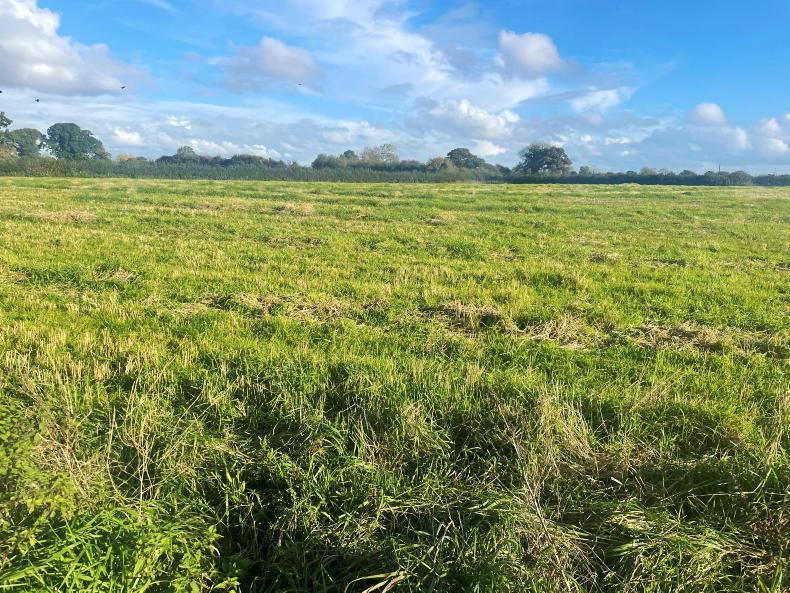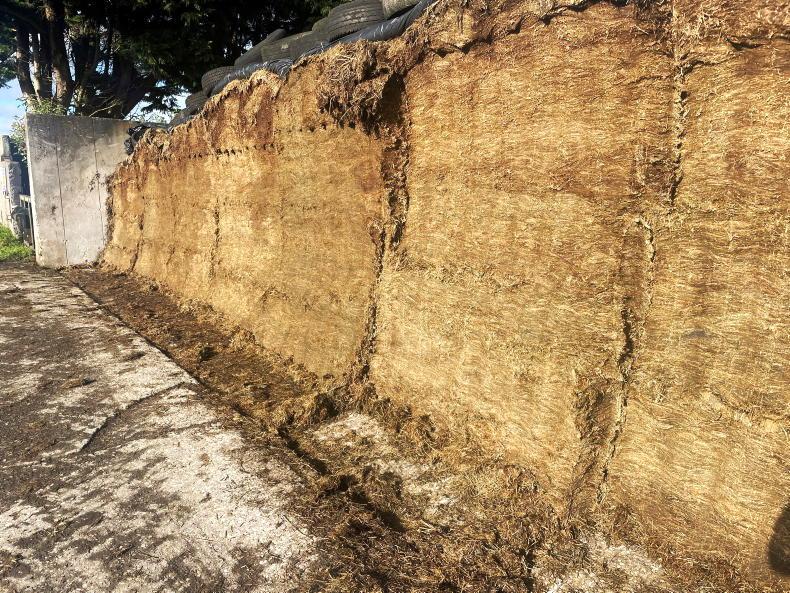Teagasc and Animal Health Ireland are holding a number of farm walks around the country at the moment with topics like, winter dosing plans, ventilation of sheds, and winter nutrition being covered at the events.
Last Friday the roadshow visited John Dunne, a beef and tillage farmer who farms on the edge of Portarlington town in
Co Offaly. John is no stranger to these pages having been a previous participant in the Teagasc/Irish Farmers Journal BETTER farm beef challenge a number of years ago.
He is now a participant in the Teagasc Future beef programme with Teagasc advisers Gabriel Trayers and Bernard Doorley helping John to drive farm performance through improvements in a number of key areas.
John has expanded the dairy calf to beef system on the farm in recent years, and the aim now is to have 200 weanlings at the back end of the year.

John Dunne participates in the Future beef programme.
Suckler weanlings are housed while dairy beef calves are wintered on forage rape and silage.
“We find the weanlings do really well on the forage rape and all cattle on the farm are sold at 24-26 months either in the mart or to the factory.”
One of the areas that John has put a huge amount of work in is his animal health plan. This plan was devised with his vet Karen Larke and his Teagasc advisers. A number of issues arose in 2022 when mortality was higher than John would have liked.
On further investigation Mycoplasma Bovis was found in a number of calves that were sent to the local regional veterinary laboratory in Athlone for a post mortem.
John’s vet Larke said: “The easy thing to do when we lose an animal is to say it’s one of those things but nine times out of ten it isn’t. The regional vet lab is invaluable in terms of getting to the bottom of issues on farms and it identified the issue here on John’s farm.”

Twenty acres of Barley straw wasn't able to be saved in August and John now plans to winter weanlings on the stubbles.
While there is no vaccination for Mycoplasma Bovis John has changed his purchasing strategy in 2023 and he now tries to buy calves in larger batches on farm as opposed to buying smaller numbers from multiple locations in marts.
Winter parasites
At last week’s walk on John’s farm, Dr Natascha Meunier from Animal Health Ireland outlined a number of issues in relation to health management for the next few months on beef farms.

Reseeded swards has meant Johns silage quality has increased in recent years. This years silage quality is 75DMD
The first was lungworm and how to prevent it becoming an issue on beef farms at this time of year. “It’s been an ideal autumn for lungworm issues on farms. Warm wet weather means that lungworms have multiplied at pasture and this has seen a lot of issues cropping up on farms over the last few weeks,” she said.
Lungworm is one of the more straightforward worms to deal with. There is no known resistance, no inhibited larvae to deal with older animals also developing natural immunity to lungworms.
A pre-housing dose with an ivermectin, doramectin or moxidectin active ingredient will mean lungs are clear and healed at housing.
Stomach worms are also an issue at this time of year with the added issue of resistance also coming into the Irish cattle herd to deal with.
There are just three active ingredients on the market to dose for stomach worms Benzimidazoles (white drenches), Levamsoles (yellow drenches) and Macrocyclic Lactones (clear injectables). The highest resistance in Ireland has been recorded in the clear drench category and Natasha advised farmers to consult with their vets about the appropriate strategy for their farm.
John has taken a different approach in recent years and faecal-samples to determine if dosing is needed. This means he hasn’t dosed for worms for several years, and he just doses for lice during the housing period.
In terms of liver fluke. Natascha went through the different doses available. She stressed three very important points about fluke dosing
Access the threat.Pick the right product.Dose at the right time.Winter feeding
The event finished by going through John’s winter feed plans. A tricky grazing season has meant that John’s store cattle are up to 100kg behind where they should be on 1 November. Cattle were also housed a month earlier on the farm.
Silage quality is very good at 75 DMD and he is hoping that performance will be high on the winter diets in the shed. “The poor weight gains will delay our slaughtering plans this year and we may opt to sell more as forward stores in the spring,” he said. Stores are currently being fed 4kg of concentrates and ad-lib silage. The ration is made up of barley, rolled oats, soya bean meal, molasses and minerals.
Mental Health
Local Teagasc adviser Bernard Doorley closed the event with a word on health and safety with particular reference to mental health
“It’s been a tough year and if you see or think that anybody is struggling over the next few months, put the hand out, lift the phone or call in for the cup of tea. You don’t know how important that that 20 minutes of your time could be to somebody.”
Teagasc and Animal Health Ireland are holding a number of farm walks around the country at the moment with topics like, winter dosing plans, ventilation of sheds, and winter nutrition being covered at the events.
Last Friday the roadshow visited John Dunne, a beef and tillage farmer who farms on the edge of Portarlington town in
Co Offaly. John is no stranger to these pages having been a previous participant in the Teagasc/Irish Farmers Journal BETTER farm beef challenge a number of years ago.
He is now a participant in the Teagasc Future beef programme with Teagasc advisers Gabriel Trayers and Bernard Doorley helping John to drive farm performance through improvements in a number of key areas.
John has expanded the dairy calf to beef system on the farm in recent years, and the aim now is to have 200 weanlings at the back end of the year.

John Dunne participates in the Future beef programme.
Suckler weanlings are housed while dairy beef calves are wintered on forage rape and silage.
“We find the weanlings do really well on the forage rape and all cattle on the farm are sold at 24-26 months either in the mart or to the factory.”
One of the areas that John has put a huge amount of work in is his animal health plan. This plan was devised with his vet Karen Larke and his Teagasc advisers. A number of issues arose in 2022 when mortality was higher than John would have liked.
On further investigation Mycoplasma Bovis was found in a number of calves that were sent to the local regional veterinary laboratory in Athlone for a post mortem.
John’s vet Larke said: “The easy thing to do when we lose an animal is to say it’s one of those things but nine times out of ten it isn’t. The regional vet lab is invaluable in terms of getting to the bottom of issues on farms and it identified the issue here on John’s farm.”

Twenty acres of Barley straw wasn't able to be saved in August and John now plans to winter weanlings on the stubbles.
While there is no vaccination for Mycoplasma Bovis John has changed his purchasing strategy in 2023 and he now tries to buy calves in larger batches on farm as opposed to buying smaller numbers from multiple locations in marts.
Winter parasites
At last week’s walk on John’s farm, Dr Natascha Meunier from Animal Health Ireland outlined a number of issues in relation to health management for the next few months on beef farms.

Reseeded swards has meant Johns silage quality has increased in recent years. This years silage quality is 75DMD
The first was lungworm and how to prevent it becoming an issue on beef farms at this time of year. “It’s been an ideal autumn for lungworm issues on farms. Warm wet weather means that lungworms have multiplied at pasture and this has seen a lot of issues cropping up on farms over the last few weeks,” she said.
Lungworm is one of the more straightforward worms to deal with. There is no known resistance, no inhibited larvae to deal with older animals also developing natural immunity to lungworms.
A pre-housing dose with an ivermectin, doramectin or moxidectin active ingredient will mean lungs are clear and healed at housing.
Stomach worms are also an issue at this time of year with the added issue of resistance also coming into the Irish cattle herd to deal with.
There are just three active ingredients on the market to dose for stomach worms Benzimidazoles (white drenches), Levamsoles (yellow drenches) and Macrocyclic Lactones (clear injectables). The highest resistance in Ireland has been recorded in the clear drench category and Natasha advised farmers to consult with their vets about the appropriate strategy for their farm.
John has taken a different approach in recent years and faecal-samples to determine if dosing is needed. This means he hasn’t dosed for worms for several years, and he just doses for lice during the housing period.
In terms of liver fluke. Natascha went through the different doses available. She stressed three very important points about fluke dosing
Access the threat.Pick the right product.Dose at the right time.Winter feeding
The event finished by going through John’s winter feed plans. A tricky grazing season has meant that John’s store cattle are up to 100kg behind where they should be on 1 November. Cattle were also housed a month earlier on the farm.
Silage quality is very good at 75 DMD and he is hoping that performance will be high on the winter diets in the shed. “The poor weight gains will delay our slaughtering plans this year and we may opt to sell more as forward stores in the spring,” he said. Stores are currently being fed 4kg of concentrates and ad-lib silage. The ration is made up of barley, rolled oats, soya bean meal, molasses and minerals.
Mental Health
Local Teagasc adviser Bernard Doorley closed the event with a word on health and safety with particular reference to mental health
“It’s been a tough year and if you see or think that anybody is struggling over the next few months, put the hand out, lift the phone or call in for the cup of tea. You don’t know how important that that 20 minutes of your time could be to somebody.”









 This is a subscriber-only article
This is a subscriber-only article










SHARING OPTIONS: